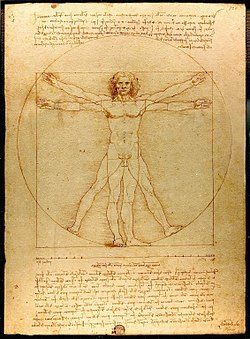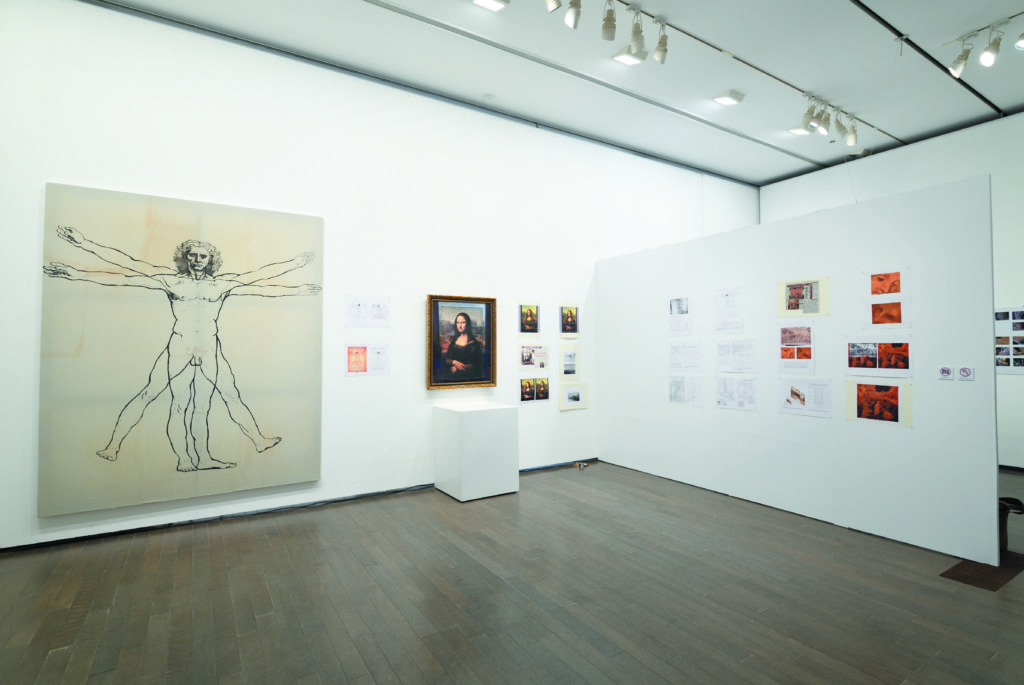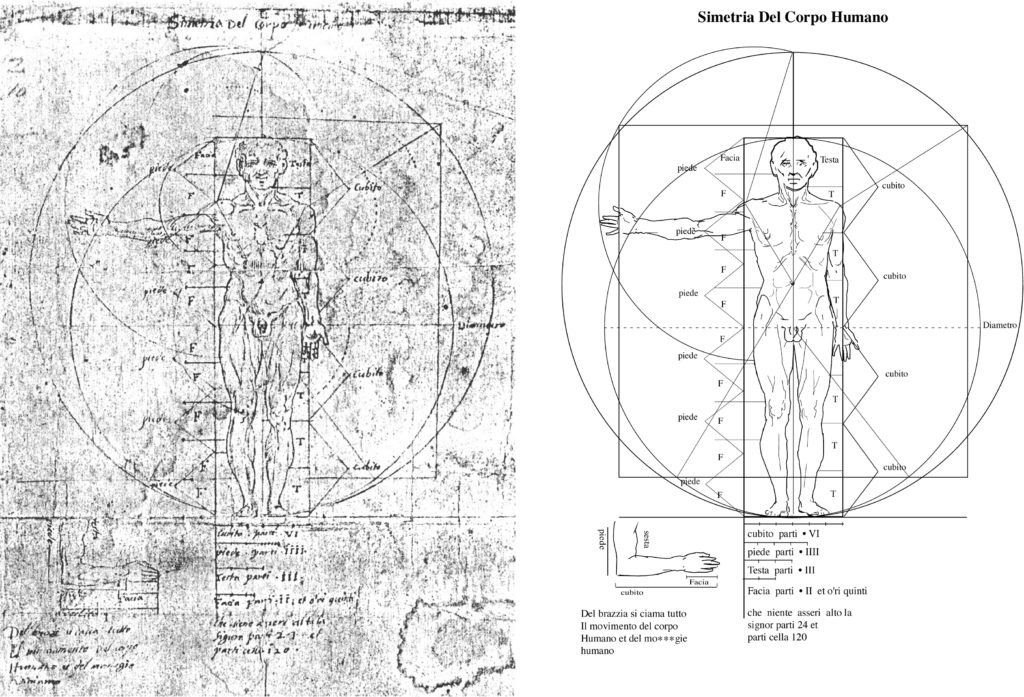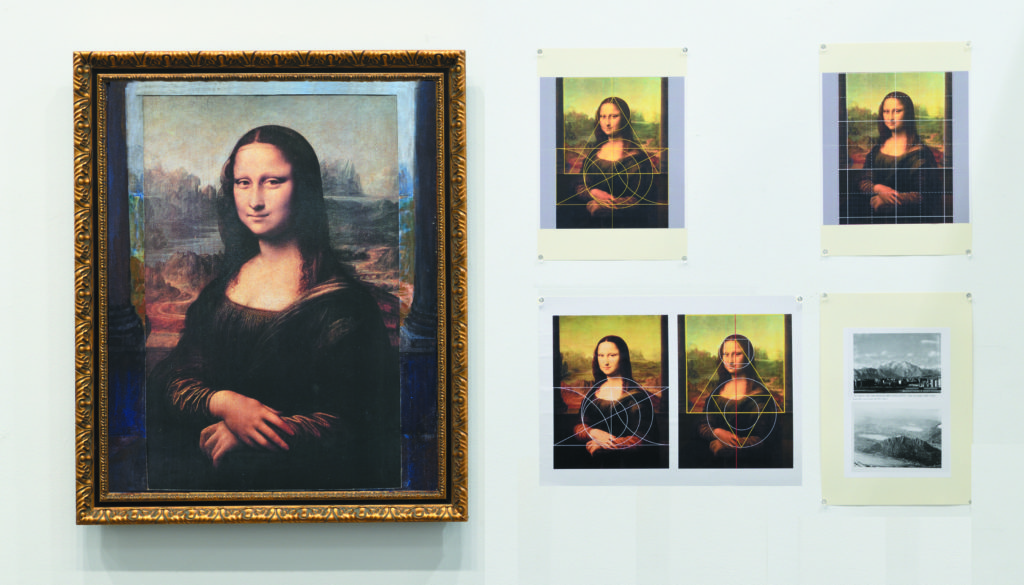Leonardo da Vinci
―― Research for the art and its proportional theory ――
After Dan Brown has published “Da Vinci Code” in 2003, Leonardo’s golden ratio prevailed over the world. There is nobody who was suspicious of this matter. However on the days when the author started this research, there was nobody who suspected of the golden ratio on this theory of proportions.
The author’s concept is to define golden series φn instead of Musical Canon of the harmonious proportion, such as 1/2, 1/3, 1/4, 1/5 …………. For this purpose author provides the thesis of “Phiogenesis of double square”, which induces φn series, such as φ= 0.61803……, φ2 = 0.38196……, φ3 = 0.233606……, on the diagonal intercepted by both arc and circle. And this thesis becomes the method of Leonardo’s system for the geometrical constructions, which were provided by the first folio of Codex Huygens and Leonardo’s famous drawing of “Vitruvian Man” in Academia Gallery of Venice.

in Academia Gallery of Venice
Panofsky connected the first folio of Codex Huygens and Leonardo’s “Vitruvian Man” because the folio represented the form and structure of the human body decided by the geometric method. The author found that on the first folio of Codex Huygens the dotted curve indicated the four terms of geometric progression of golden ratio which Panofsky had missed. In the first chapter of author’s paper the concept of “Phiogenesis of double square” was introduced from the first folio of Codex Huygens. The author considers that this folio is the copy of the lost “Sforza’s drawing theory” and expresses Leonardo’s principle of drawing figures and also perspective method through the sentence “how the lines, proportion, shape, position and distance are seen and where they are”.


From this first folio the geometric progression of golden ratio is introduced although Panofsky missed it in his research of Codex Huygens. Leonardo’s “Vitruvian Man” was dealt with in the three stages of different periods, in which the first stage is approximate value of 2/3, the second stage is φ and the third stage is φn. Approximate value of golden section was used in the seventh folio of Codex Huygens, golden section in the Oxford’s folio and the geometric progression of golden ratio in “Vitruvian Man”. Vitruvius’ circle and the position of basic line were used in the same way both in Oxford’s folio and Codex Huygens. “Vitruvian Man” was the highest stage because the geometric progression of golden ratio was introduced from the first folio. Therefore common judgment of the time of “Vitruvian Man” in Academia Gallery of Venice, 1492 is not correct.
Although Panofsky stated the close connection between the first folio of Codex Huygens and Leonado’s “Vitruvian Man”, there are problems that the first folio and the seventh folio of Codex Huygens and the “Vitruvian Man” indicate three different phase and these phase respectively correspond the approximate value of φ, φ and φn series. Looking into Leonardo’s own manuscript of 1492, Paris Codex B folio 13v (Library of the Institute of France) indicates informal construction for pentagon. For the proper geometrical construction of pentagon, it needs accurate φ, but in this Codex B in 1490 shows false construction of pentagon, so to speak German Geometry, so that in that time Leonardo should not know proper φ, so that he could not draw his famous “Vitruvian Man”.
This is the reason that the author treats the first folio of Codex Huygens, which provided φn series. And the geometrical construction using golden ratio enlarged the depth of the “Last Supper”. However in this case Leonardo applied only golden ratio on the legitimate construction method in 1490’s. Therefore system of Codex Huygens was accomplished after 1490’s and maybe in 1500’s φn drawing.
The first folio of Codex Huygens is not kept in the existing codex and we must ask the period when Leonardo found the geometric progression of golden ratio from this folio. And the author examined the period that Leonardo accomplished the system of Codex Huygens for his perspective drawing of background drawing of the “Adoration of the Magi”.



In this paper the author compared Leonardo’s description and his related works, after his representative works were geometrically analyzed. When the author started the research of the “Vitruvian Man”, he thought that Leonardo might perceive the “Phiogenesis of double square”, related with the composition of wooden painting of the “Adoration of the Magi”. However there arose a discrepancy between the period of the “Vitruvian Man” and the “Adoration of the Magi.”
It is because Carlo Pedretti connected the Codex Huygens with Leonardo’s theory of painting, and Irma Richter referred its 7th folio as it reflected the image of Leonardo’s lost “Treaties on Paintings” before 1498. In the common idea of Leonardo’s work, the “Adoration of the Magi” is in his early period as 1480’s and the “Vitruvian Man” as those years of 1490-2.
To solve this problem in the 3rd chapter, the golden ratio was examined in Leonardo’s description. For the preliminary study for 4th chapter on Leonardo’s linear perspective, Alberti’s statements of «superbipartienti» in his “Della pittura” has been accepted as the ratio of 2/3 and not explained as the value of the golden ratio so that we need to know accurate value of «superbipartienti». Leonardo applied «superbipartienti» as the golden ratio in his construction of inner space of the room of the “Last supper”. This new interpretation of «superbipartienti» in the preparatory drawing for the “Last Supper” was derived from Leonardo’s interpretation on both of Arundel folio 153r and Madrid Ⅱ folio 48r. Therefore Leonardo’s own golden ratio varied according to his career stages from 2/3 and φ (=0.6184…) to the geometric progression of golden ratio on his linear perspective.
It is understood through the restoration of the “Last Supper” that the first application of the golden ratio was done not on the background drawing of the “Adoration of the Magi” but on the “Last Supper”. Present room is that the depth of which had been enlarged multiplying by Φ (=1.6184…), the larger value of golden ratio.
The author found Leonardo’s new method, which is the key getting into his procedure of drawing liner perspective. The first folio of the Codex Huygens is the mathematical progression of φn, namely the series of golden ratio on the diagonal of the double square (“Phiogenesis of double square”). In this folio, there is a description about the linear perspectives, but the author dismissed it when he tackled with the “Vitruvian Man”, famous drawing in the Academia Gallery of Venice.
The golden ratio series are not only for proportions of “Vitruvian Man” but also for his linear perspectives. Using the author’s proposition, “Phiogenesis of double square” give the key for the famous background drawing of the “Adoration of the Magi”.
Leonardo at first tackled with the “Legitimate constructions” on a former square space of the “Last Supper”. From this procedure, the author found that the reminiscence of the gouge lines, which were not used on the contemporary Last Supper’s inner space, should be gouge lines on the square inner space of the former Last Supper. Using the former gouge lines, Leonardo expand the room, with the ratio Φ (=1.618…). To compare the gouge lines with “Legitimate constructions” and “Distance Point constructions”, it is easier to accord with the golden ratio in the latter’s case than in the former one.
The author’s key, “Phiogenesis of double square” in the first folio of Codex Huygens should be found later phase of Leonardo’s 1500’s, at that times during his studies on Euclidian geometry.
Then Leonardo’s background drawing of the “Adoration of the Magi” as the same as his “Vitruvian Man” in Academia Gallery of Venice should be in 1500’s.
Leonardo could calculate the golden section geometrically only after the contact with Mathematician Luca Pacioli, and above all he could treat φn only after the year of 1504, when he treated his idea of “equiparentia” in Codex Madrid and Euclidian theorem φ in Codex Paris K2 folio 26r.


In author’s research the geometric progression of golden ratio introduced from the geometric proposition presented in the 1st chapter was confirmed in Leonardo’s works in the chapters from the 2nd to the 7th. And the author proved that this principle was used in Leonardo’s theory of mankind body proportion and drawing system of linear perspective.
A new point of view is therefore confirmed and Codex Huygens is understood to be the copy of the lost “Sforza’s drawing theory” through the analysis of works even if the folios from the 1st to 6th of Codex Huygens were added in about 1508 in spite of Codex Oxford. In the 7th chapter “Mona Lisa” was drawn as the symbol of completed “Sforza’s drawing theory” in another case of the portrait of Lisa del Giocondo. When the restoration was done inserting the columns encircling the background scenery, the picture was coincident with the expression of graticola in the article “about the rule of artist” in the 2nd chapter of “Sforza’s drawing theory”.
The intercept of almond shape is √2×√3/4 at the foot of “a man framed by a square” of Cesariano revision which is 0.6123… and a very accurate approximation of φ. In addition with this expression Leonardo’s circles were used to encircle the body of “Mona Lisa” and the circle was the one based by this arc which Leonardo used as Vitruvius’ circle before he did “the big circle” of Codex Huygens the 1st folio.
The intercept on the base of square indicates one step of the paradigm of Leonardo’s progress in the golden ratio. There is a basic thought of the golden ratio under Leonardo’s writing “do not allow persons to read my principle who are not mathematicians”.
In the last chapter the author insists that Leonardo could not draw his “Vitruvian Man” before the beginning of 1490s but after the day when he wrote the sentence on Codex Windsor 19145r.
Leonardo wrote “ I have struggled for a long time to solve the quadrature problem and at last I gained the result of the angle having the curved sides, that is the angle “e” which has the equal curvature given from the same circle at 22:00 in the night before 1st May 1509”. It is imagined that the trial of geometrical research based on “Logos Shinmetoria” stated as above was not enough cultivated to connect with other disciplines of drawing yet.
There is a difference of nearly 20 years between the periods of Leonardo’s “Vitruvian Man” which is considered to be drawn in about 1492 as commonly accepted and Codex Windsor folio 19145r of the 1st May 1509. But if the period of Leonardo’s “Vitruvian Man” is supposed from 1908 to first half of 09, the difference disappears. Moreover the area of Archimedes’ circle of Codex Windsor folio 12280r researched by Irle and Schröer is connected to Leonardo’s “Vitruvian Man” and it is shown that Leonardo convinced to possibly solve “Logos Shinmetoria” geometrically where his “Ludo geometrico” was not merely a play.
The results of research of Dr. Mukaigawa can be summarized as blow.
1. Leonardo da Vinci applied geometry to determine the composition of the paintings.
2. Dr. Mukaikawa discovered how Leonardo applied the golden ratio to the composition and named it ” Fiogenesis of double square”.
3. Dr. Mukaikawa has clarified Leonardo’s painting composition method regarding the “Vitruvian Man “, the “Adoration of Magi” and the “Last Supper”.
4. In the “Vitruvian Man”, Dr. Mukaikawa clarified the composition of the circle surrounding the human body.
5. In the painting composition, Leonardo first applied an approximation of golden ratio, then golden ratio, and in his “Vitruvian Man”, applied a geometric progression of golden ratio.
6. The theory was applied to “Mona Lisa” in Louvre Museum. An important element is the pillars that were once drawn on both sides of the figure, which allows us to confirm Leonard’s construction method.
7. The data of production year of Leonardo’s paintings can be revised.
